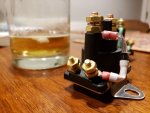AShipShow
Lieutenant Commander
- Joined
- Jul 8, 2016
- Messages
- 1,803
Thoughts welcome....
I took apart my old trim solenoids because I tested them and was getting very high resistance across the main terminals. I ordered new ones so I figured I'd investigate what the inside looked like... they are surprisingly repairable... in fact, I posted a video on my YouTube channel on how to test them and fix (at your own risk)... I don't plan on using the fixed ones, just keeping them in my tool box as backups.
all that being said, I noticed the failure mode of BOTH my solenoids was heavy pitting and carbon buildup on the copper studs and disk.
this is because these solenoids are making and breaking contact on a high current inductive load. When you open a switch on a motor or coil, you get significant arcing because the coil in the motor produces high voltage spikes... these spikes cause arcing at the contacts which constantly erodes and contaminates the contacts.
industrial motor contractors get away with this by using better plating, snubber diodes, and or sacrificial discharge tips on the contacts.
from what I can tell, mercruiser has done nothing to mitigate the issue.
my idea is to place a fly back diode from the ground terminal to the positive trim motor terminal on each solenoid.
They work by conducting the motors dissipating current thru the diode back to the motor positive wire...
it works like below (from wikipedia, check wikipedia page for further reading on flyback diodes)

hope this makes sense...
as far as the diodes I'm using, I happened to have some 1n5822 diodes in my parts bins. Pretty much anything would work as long as its reverse voltage is higher than 40v or more and its max instantaneous forward current is over 80amps or so as there will only brief current spikes.
hope this makes sense... i might be way off base, but it should work and at least give me quite a bit more life from my new trim solenoids for the cost of 2 20 cent diodes.

I took apart my old trim solenoids because I tested them and was getting very high resistance across the main terminals. I ordered new ones so I figured I'd investigate what the inside looked like... they are surprisingly repairable... in fact, I posted a video on my YouTube channel on how to test them and fix (at your own risk)... I don't plan on using the fixed ones, just keeping them in my tool box as backups.
all that being said, I noticed the failure mode of BOTH my solenoids was heavy pitting and carbon buildup on the copper studs and disk.
this is because these solenoids are making and breaking contact on a high current inductive load. When you open a switch on a motor or coil, you get significant arcing because the coil in the motor produces high voltage spikes... these spikes cause arcing at the contacts which constantly erodes and contaminates the contacts.
industrial motor contractors get away with this by using better plating, snubber diodes, and or sacrificial discharge tips on the contacts.
from what I can tell, mercruiser has done nothing to mitigate the issue.
my idea is to place a fly back diode from the ground terminal to the positive trim motor terminal on each solenoid.
They work by conducting the motors dissipating current thru the diode back to the motor positive wire...
it works like below (from wikipedia, check wikipedia page for further reading on flyback diodes)

hope this makes sense...
as far as the diodes I'm using, I happened to have some 1n5822 diodes in my parts bins. Pretty much anything would work as long as its reverse voltage is higher than 40v or more and its max instantaneous forward current is over 80amps or so as there will only brief current spikes.
hope this makes sense... i might be way off base, but it should work and at least give me quite a bit more life from my new trim solenoids for the cost of 2 20 cent diodes.























